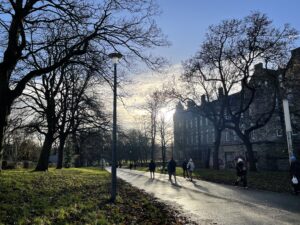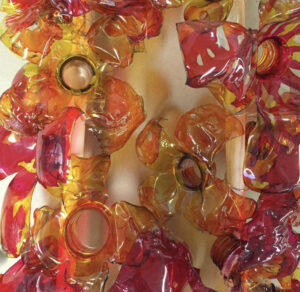Week 10 – Practice Humility
Entering the Anthropocene, defined by humanity’s unparalleled influence on Earth’s systems, shifts our perception of time and responsibility. The Capitalocene is propelled by our capitalist systems which we, as a collective, need to reflect on. By cultivating humility in the face of our immense impact, we pave the way for a more conscientious and respectful coexistence with the Earth and all its inhabitants.
What I have found to be incredibly useful to use as a rule of thumb is “The Guiding Principles for Slow Design” introduced by Strauss and Alastair Fuad-Luke. These principles are a fundamental ground to move forward with in my Graphic Design career.
 The Meadows. Photo by Christina Yang.
The Meadows. Photo by Christina Yang.
The Slow Design principles can be applied to anything including the University of Edinburgh’s buildings. Here is my take: instead of appearing to be perfect, the campus buildings can incorporate exposed structural elements and designs that reveal the history of student experiences. To expand beyond functionality, the architecture can encourage expressions by creating spaces that inspire creativity. Furthermore, spaces for quiet reflection and open areas allow students to reflect and process. The architecture design can also promote community by designing communal areas for engagement such as group study spaces and help students participate by fostering a sense of community within the university. Last but not least, acknowledging the need for change and adapting to the need for different spaces, usage of sustainable materials, and having flexibility are elements to a holistic sense of wellness.
It is interesting to reflect on the relationship between design and time since design, in its various forms, encapsulates perspectives on how time is perceived. One aspect is “slow time” which emphasizes the value of unhurried processes, mindful craftsmanship, and sustainable practices. Designs that embody “slow time” prioritize longevity. Another notion is “long now” which represents a far-reaching perspective that transcends immediate concerns, which means sustaining across generations and enduring solutions over short-term gains. This emphasizes durability, adaptability, and a sense of responsibility. Then there are “presents in the making” that reveal our relationship with materials influenced by our current perceptions of time. Together, these concepts become a canvas reflecting societal attitudes, cultural values, and evolving understandings of time. Designing a future embedded with awareness is one step closer to building a better tomorrow. As we confront the reality of living in an era where our actions hold the power to mold the Earth’s fate, the concept of time undergoes a profound transformation – it urges us to pause, reflect, and acknowledge our limitations.
Van der Ryn and Cowan’s Five Principles for ecological design:
- Solutions Grow from Place
- Ecological Accounting Informs Design
- Design with Nature
- Everyone is a Designer
- Make Nature Visible
My manifesto:
- The vision is for designers, architects, and consumers all to prioritize the planet for sustainable living.
- To take responsibility for material sourcing and use innovative and cradle-to-cradle principles to minimize environmental impact.
- To ensure fair labour conditions and have ethical production throughout.
- To educate and collaborate throughout disciplines to create a new generation of sustainable thinkers.
- To integrate elements of nature into design, drawing from its efficiency and promoting biodiversity.
Class manifesto combined:
- Design for the future using the past. Use existing materials in circulation and knowledge and ideas to develop future ones to benefit the environment. Find recycling methods for all waste.
- Design following and for nature. Nature has already figured out the most successful way to thrive, let’s copy. Create for all, human and non-human. Eliminate the binary opposition between humans and nature. Let us breathe with the earth.
- Design to link up – Interlink between different sectors and processes. Become circular. Good design is a natural continuation. Understand the lifecycle of what is created.
- Take responsibility. Be critical about projects, be transparent where designs have failed, boycott carbon-heavy clients. Acknowledge the balance between designers & stakeholders. Recognize the systems at work.
- Respect the material.
- Design with place in mind. Acknowledge and respect what’s already there. Design should be a reflection of the context of its location. No one size fits all! Consider the local climate, and embrace the skills of local people and materials from that specific area.
- Un/non-design. Conserve, leave alone, don’t make, don’t take up space, and even subtract (rather than add)!
Reference list
Harkness, H. (2023) Theme 4_Lecture A [PDF], Environmental Futures: Time, Hope and Possibilities in Design. University of Edinburgh.
Van der Ryn, S., & Cowan, S. (2007). Ecological design. 10th anniversary ed. Washington, DC, Island Press.
 A park near Dean Village. Photo by Christina Yang.
A park near Dean Village. Photo by Christina Yang. Plastic creation by me. Photo by Christina Yang.
Plastic creation by me. Photo by Christina Yang. Playground in Leith. Photo by Christina Yang.
Playground in Leith. Photo by Christina Yang.